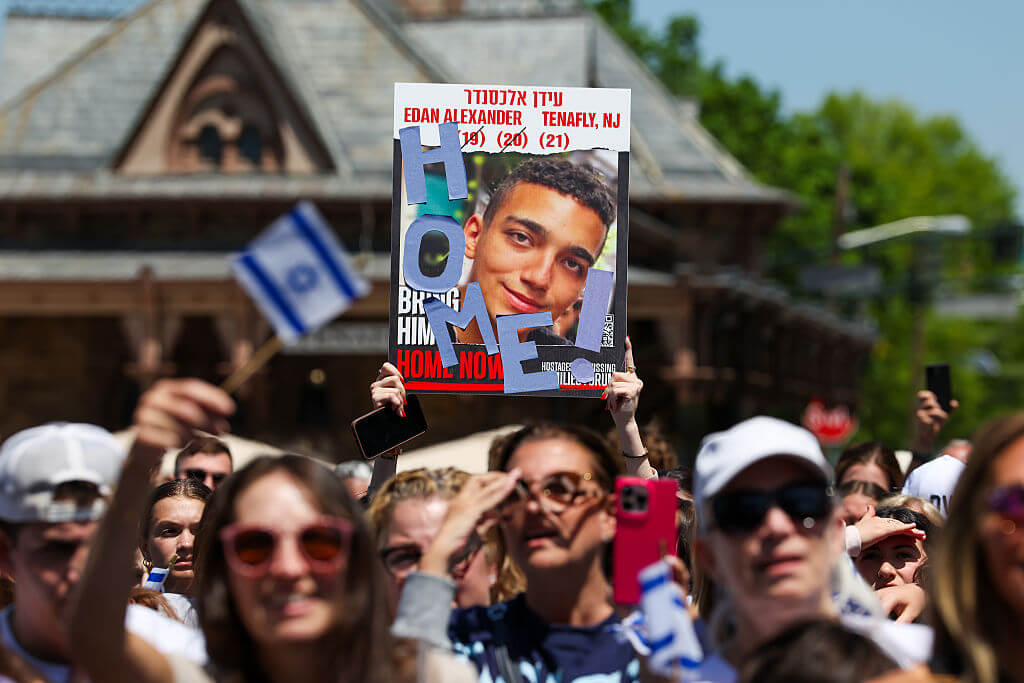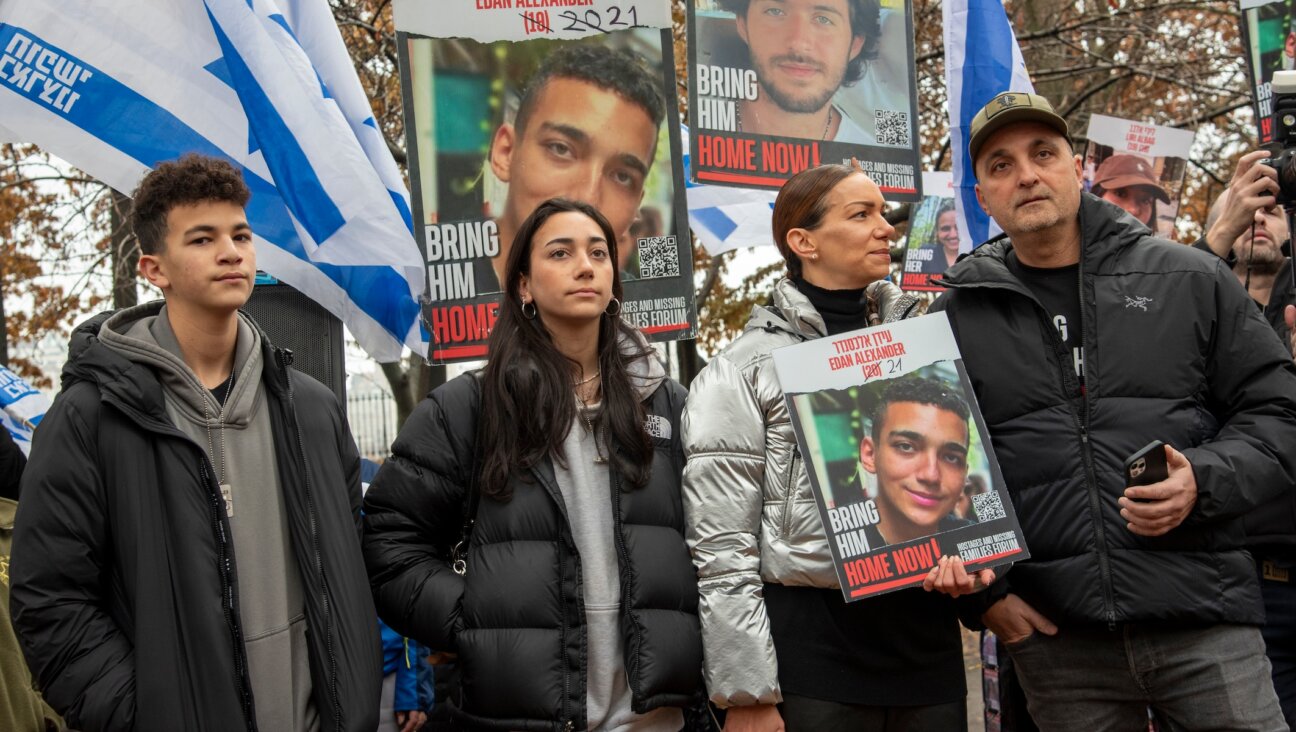Jewish Woman in Iconic World War II Kiss Photo Dies at 92

Image by U.S. Archives
Greta Zimmer Friedman, the Jewish refugee whose Times Square kiss from a sailor on the day World War II ended became an iconic photo, has died.
Friedman, who had been living at an assisted living facility in northern Virginia, died Sept. 8, CBS reported, quoting her son, Joseph Friedman. She was 92. She will be buried at Arlington National Cemetery alongside her husband, Mischa Elliott Friedman.
For years, the identities of the people in the photograph by Life Magazine photographer Alfred Eisenstaedt, taken on the evening of Aug. 14, 1945, after the news of Japan’s surrender was broadcast, were unknown.
After an appeal from Life Magazine in 1980, a number of people identified themselves as being in the photo. A 2012 book, “The Kissing Sailor: The Mystery Behind the Photo That Ended World War II,” used forensic analysis to validate two claims, by George Mendonsa, a sailor returned from the Pacific, and Zimmer, who had fled Austria with her younger sisters in 1938.
Mendonsa was in Manhattan on his first date with Rita Petry. News of Japan’s surrender broke while they were watching a movie. They went to a bar to celebrate and then headed to Times Square. Mendonsa saw Zimmer, a dental assistant, and mistook her for a nurse. He had been grateful to nurses since May 11 of the same year, when kamikaze planes hit his aircraft carrier, and he watched nurses from a hospital ship arrive to tenderly care for the wounded.
He grabbed Zimmer, a grinning Petry looking on, kissed her, and continued on. (The kiss didn’t dampen the young couple’s enthusiasm for one another; Mendonsa and Petry married and remain a couple in Rhode Island to this day.) A U.S. Navy photojournalist, Lt. Victor Jorgensen, caught the same picture from a different angle.
Zimmer became a costumer and for a time was part of a circle of theater professionals in New York. She met Friedman, a doctor, and they married in 1956.
The kiss became Eisenstaedt’s most iconic photo. Its symmetry and natural light capture the fading New York day. The grinning spectators encapsulate the relief Americans felt at the end of the war. Posters of the photo hang on many walls, and countless fans have tried to replicate the moment.
Eisenstaedt, himself a Jewish refugee, was already well known. He shot one of the best known photos of Nazi Propaganda Minister Joseph Goebbels at a League of Nations conference in Geneva in 1933. In it Goebbels glares at the camera. Moments earlier, Eisenstaedt had captured Goebbels grinning. Some photography enthusiasts have speculated that in the interim Goebbels learned Eisenstaedt was Jewish.
In recent years, the Times Square photo has prompted discussion over whether Mendonsa’s actions were appropriate. Zimmer did not anticipate the kiss.
Her son, Joseph, earlier this month told The New York Daily News that his mother was sympathetic to those views, but also to Mendonsa, with whom she was reunited for a CBS news item in 2012.
“My mom always had an appreciation for a feminist viewpoint, and understood the premise that you don’t have a right to be intimate with a stranger on the street,” he said, but added that she thought Mendonsa to be “a lovely person.”
“She didn’t assign any bad motives to George in that circumstance, that situation, that time,” he said.
The Forward is free to read, but it isn’t free to produce

I hope you appreciated this article. Before you go, I’d like to ask you to please support the Forward.
Now more than ever, American Jews need independent news they can trust, with reporting driven by truth, not ideology. We serve you, not any ideological agenda.
At a time when other newsrooms are closing or cutting back, the Forward has removed its paywall and invested additional resources to report on the ground from Israel and around the U.S. on the impact of the war, rising antisemitism and polarized discourse.
This is a great time to support independent Jewish journalism you rely on. Make a gift today!
— Rachel Fishman Feddersen, Publisher and CEO
Support our mission to tell the Jewish story fully and fairly.
Most Popular
- 1

Fast Forward Ye debuts ‘Heil Hitler’ music video that includes a sample of a Hitler speech
- 2

Opinion It looks like Israel totally underestimated Trump
- 3

Culture Is Pope Leo Jewish? Ask his distant cousins — like me
- 4

Fast Forward Student suspended for ‘F— the Jews’ video defends himself on antisemitic podcast
In Case You Missed It
-

News In Edan Alexander’s hometown in New Jersey, months of fear and anguish give way to joy and relief
-

Fast Forward What’s next for suspended student who posted ‘F— the Jews’ video? An alt-right media tour
-

Opinion Despite Netanyahu, Edan Alexander is finally free
-

Opinion A judge just released another pro-Palestinian activist. Here’s why that’s good for the Jews
-
Shop the Forward Store
100% of profits support our journalism
Republish This Story
Please read before republishing
We’re happy to make this story available to republish for free, unless it originated with JTA, Haaretz or another publication (as indicated on the article) and as long as you follow our guidelines.
You must comply with the following:
- Credit the Forward
- Retain our pixel
- Preserve our canonical link in Google search
- Add a noindex tag in Google search
See our full guidelines for more information, and this guide for detail about canonical URLs.
To republish, copy the HTML by clicking on the yellow button to the right; it includes our tracking pixel, all paragraph styles and hyperlinks, the author byline and credit to the Forward. It does not include images; to avoid copyright violations, you must add them manually, following our guidelines. Please email us at [email protected], subject line “republish,” with any questions or to let us know what stories you’re picking up.














